Evaluation and Solution Suggestions for Engineering and Workmanship Failures during Design and Installation of Solar Power Plants
Abstract
1. Introduction
2. Materials and Methods
2.1. Solar Inverters
2.1.1. String Inverters
2.1.2. Central Inverters
2.1.3. Micro Inverters
2.2. Important Parameters to the Most Efficient/Maximum Outputs from the Solar Inverter
2.2.1. MPPT and Maximum DC Input Voltage
2.2.2. Starting Voltage
2.2.3. Minimum Input Voltage
2.2.4. Operating Voltage Range
2.2.5. Maximum Power Range
2.2.6. MPPT String Connection Failures
3. Experimental Results and Discussion
3.1. MPPT Connection Failures of Solar Inverters
3.2. Incorrect Network Configuration of the Camera System
3.3. Fixing the Lighting Time Settings
3.4. Other Improvements
4. Conclusions
Author Contributions
Funding
Data Availability Statement
Conflicts of Interest
References
- Lidula, N.W.A.; Rajapakse, A.D. Microgrids research: A review of experimental microgrids and test systems. Renew. Sustain. Energy Rev. 2011, 15, 186–202. [Google Scholar] [CrossRef]
- Zhang, F.; Meng, C.; Yang, Y.; Sun, C.; Ji, C.; Chen, Y.; Yang, G. Advantages and challenges of DC microgrid for commercial building a case study from Xiamen university DC microgrid. In Proceedings of the IEEE First International Conference on DC Microgrids (ICDCM), Atlanta, GA, USA, 7 June 2015. [Google Scholar]
- Salomonsson, D.; Sannino, A.; Low-Voltage, D.C. Distribution System for Commercial Power Systems With Sensitive Electronic Loads. IEEE Trans. Power Deliv. 2007, 22, 1620–1627. [Google Scholar] [CrossRef]
- Jonaitis, A.; Gudzius, S.; Morkvenas, A.; Azubalis, M.; Konstantinaviciute, I.; Baranauskas, A.; Ticka, V. Challenges of integrating wind power plants into the electric power system: Lithuanian case. Renew. Sustain. Energy Rev. 2018, 94, 468–475. [Google Scholar] [CrossRef]
- Lorenz, C. Balancing reserves within a decabonized European electricity System in 2050—From market developments to model insights. In Proceedings of the 2017 14th International Conference on the European Energy Market (EEM), Dresden, Germany, 6–9 June 2017; pp. 1–8. [Google Scholar]
- El-Sayed, M.M.; El-Ela, A.A.A.; El-Sehiemy, R.A. Effect of photovoltaic system on power quality in electrical distribution networks. In Proceedings of the 2016 Eighteenth International Middle East Power Systems Conference (MEPCON), Cairo, Egypt, 27–29 December 2016; pp. 1005–1012. [Google Scholar]
- Nayan, M.F.; Ullah, S.M.S.; Saif, S.N. Comparative analysis of PV module efficiency for different types of silicon materials considering the effects of environmental parameters. In Proceedings of the 2016 3rd International Conference on Electrical Engineering and Information Communication Technology (ICEEICT), Dhaka, Bangladesh, 22–24 September 2016; pp. 1–6. [Google Scholar]
- Rauf, S.; Wahab, A.; Rizwan, M.; Rasool, S.; Khan, N. Application of Dc-grid for Efficient use of solar PV System in Smart Grid. Procedia Comput. Sci. 2016, 83, 902–906. [Google Scholar] [CrossRef]
- Sinapis, K.; Tsatsakis, K.; Dörenkämper, M.; Van Sark, W.G.J.H.M. Evaluation and Analysis of Selective Deployment of Power Optimizers for Residential PV Systems. Energies 2021, 14, 811. [Google Scholar] [CrossRef]
- Vignola, F.; Mavromatakis, F.; Krumsick, J. Performance of PV inverters. In Proceedings of the 37th ASES Annual Conference, San Diego, CA, USA, 3–8 May 2008. [Google Scholar]
- Pakkiraiah, B.; Durga Sukuma, G. Research Survey on Various MPPT Performance Issues to Improved the Solar PV System Efficiency. J. Sol. Energy 2016, 2016, 8012432. [Google Scholar] [CrossRef]
- Havrlík, M.; Libra, M.; Poulek, V.; Kouřím, P. Analysis of Output Signal Distortion of Galvanic Isolation Circuits for Monitoring the Mains Voltage Waveform. Sensors 2022, 22, 7769. [Google Scholar] [CrossRef] [PubMed]
- Saadi, A.; Moussi, A. Neural network use in the MPPT of photovoltaic pumping system. J. Renew. Energy ICPWE 2003, 4, 39–45. [Google Scholar]
- Kadri, R.; Gaubert, J.-P.; Champenois, G. Centralized MPPT with string current diverter for solving the series connection problem in photovoltaic power generation system. In Proceedings of the International Conference on Clean Electrical Power (ICCEP), Ischia, Italy, 10 October 2011. [Google Scholar]
- Ahmad, A.; Loganathan, R. Real-Time Implementation of Solar Inverter with Novel MPPT Control Algorithm for Residential Applications. Energy Power Eng. 2013, 5, 427–435. [Google Scholar] [CrossRef]
- Yang, Y.; Wen, H. Adaptive perturb and observe maximum power point tracking with current predictive and decoupled power control for grid connected photovoltaic inverters. J. Mod. Power Syst. Clean Energy 2019, 7, 422–432. [Google Scholar] [CrossRef]
- Chen, M.; Ma, S.; Wu, J.; Huang, L. Analysis of MPPT Failure and Development of an Augmented Nonlinear Controller for MPPT of Photovoltaic Systems under Partial Shading Conditions. Appl. Sci. 2017, 7, 95. [Google Scholar] [CrossRef]
- Lillo-Bravo, I.; González-Martínez, P.; Larrañeta, M.; Guasumba-Codena, J. Impact of Energy Losses Due to Failures on Photovoltaic Plant Energy Balance. Energies 2018, 11, 363. [Google Scholar] [CrossRef]
- David, M.; Jahn, U.; Tjengdrawira, C.; Theologitis, I.T. Technical Risks in PV Projects—Report on Technical Risks in PV Project Development and PV Plant Operation, Solar Bankability. 2018. Available online: http://www.solarbankability.org/fileadmin/sites/www/files/documents/D1.1_2.1_Technical_risks_in_PV (accessed on 20 September 2022).
- Tur, M.R.; Colak, İ.; Bayindir, R. Effect of Faults in Solar Panels on Production Rate and Efficiency. In Proceedings of the International Conference on Smart Grid (icSmartGrid), Nagasaki, Japan, 4 December 2018. [Google Scholar] [CrossRef]
- Hwang, H.R.; Kim, B.S.; Cho, T.H. Implementation of a Fault Diagnosis System Using Neural Networks for Solar Panel. Int. J. Control Autom. Syst. 2019, 17, 1050–1058. [Google Scholar] [CrossRef]
- Solanki, S.G.; Ramasamy, M.; Manzoor, S.; Ganesalingam, U.K.R. Design & Development for OFF grid Solar Inverter. In Proceedings of the IEEE 4th International Symposium in Robotics and Manufacturing Automation (ROMA), Perambalur, India, 10 December 2018. [Google Scholar] [CrossRef]
- Kratzenbergab, M.G.; Deschamps, E.M.; Nascimento, L.; Rütheb, R.; Zürn, H.H. Optimal photovoltaic inverter sizing considering different climate conditions and energy prices. Energy Procedia 2014, 57, 226–234. [Google Scholar] [CrossRef]
- Famoso, F.; Lanzafame, R.; Maenza, S.; Scandura, P.F. Performance comparison between micro-inverter and string-inverter Photovoltaic Systems. Energy Procedia 2015, 81, 526–539. [Google Scholar] [CrossRef]
- Tariq, M.S.; Butt, S.A.; Khan, H.A. Impact of module and inverter failures on the performance of central-, string-, and micro-inverter PV systems. Microelectron. Reliab. 2018, 88–90, 1042–1046. [Google Scholar] [CrossRef]
- Harb, S.; Kedia, M.; Zhang, H.; Balog, R.S. Microinverter and string inverter grid-connected photovoltaic system—A comprehensive study. In Proceedings of the IEEE 39th Photovoltaic Specialists Conference (PVSC), Tampa, FL, USA, 16 June 2013. [Google Scholar] [CrossRef]
- Visa, I.; Duta, A.; Moldovan, M.; Burduhos, B.; Neagoe, M. Solar Energy Conversion Systems in the Built Environment, 1st ed.; Green Energy and Technology (GREEN); Springer: Berlin/Heidelberg, Germany, 2020; pp. 186–226. [Google Scholar]
- Mayer, M.J.; Gróf, G. Techno-economic optimization of grid-connected, ground-mounted photovoltaic power plants by genetic algorithm based on a comprehensive mathematical model. Sol. Energy 2020, 202, 210–212. [Google Scholar] [CrossRef]
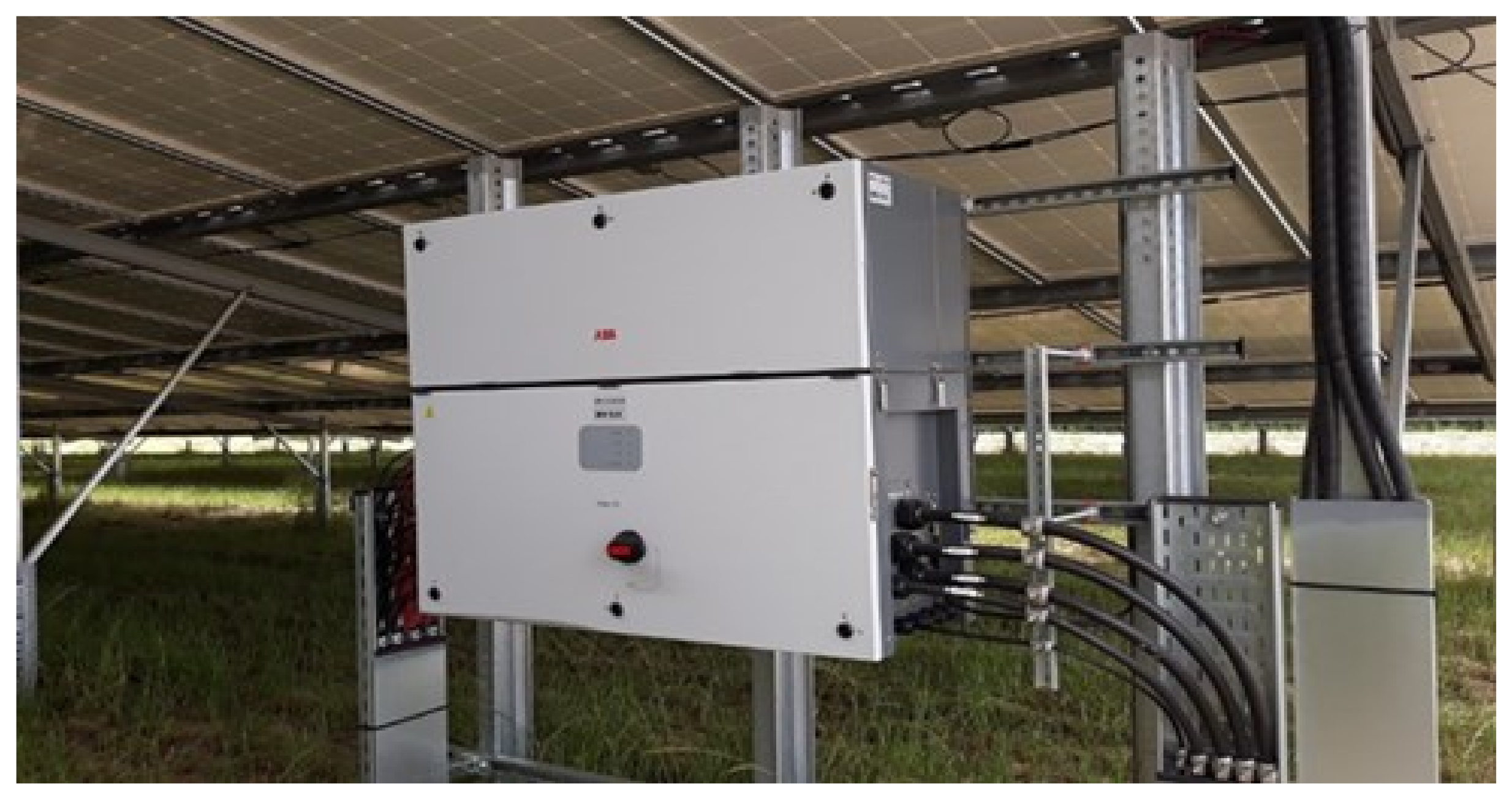
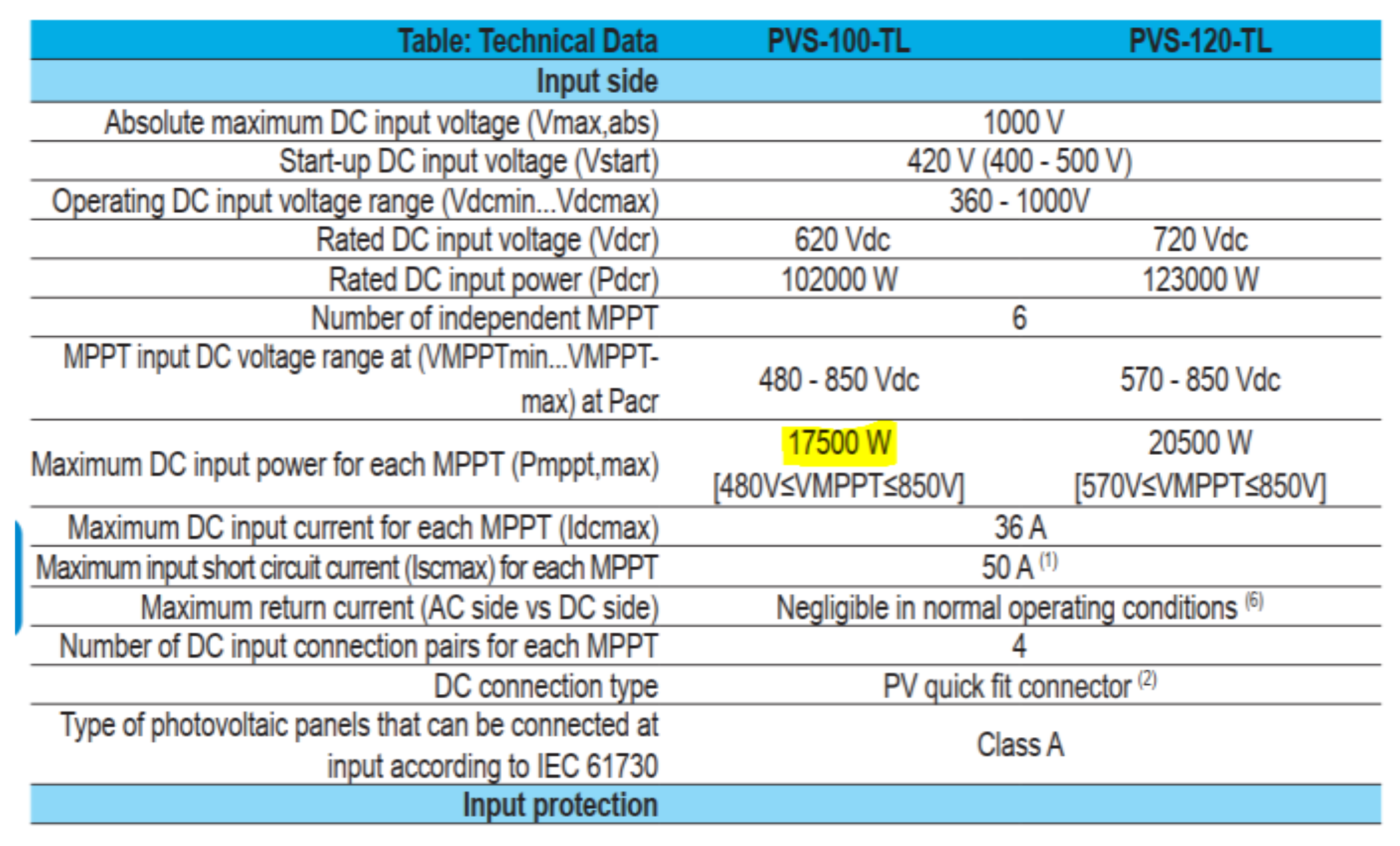
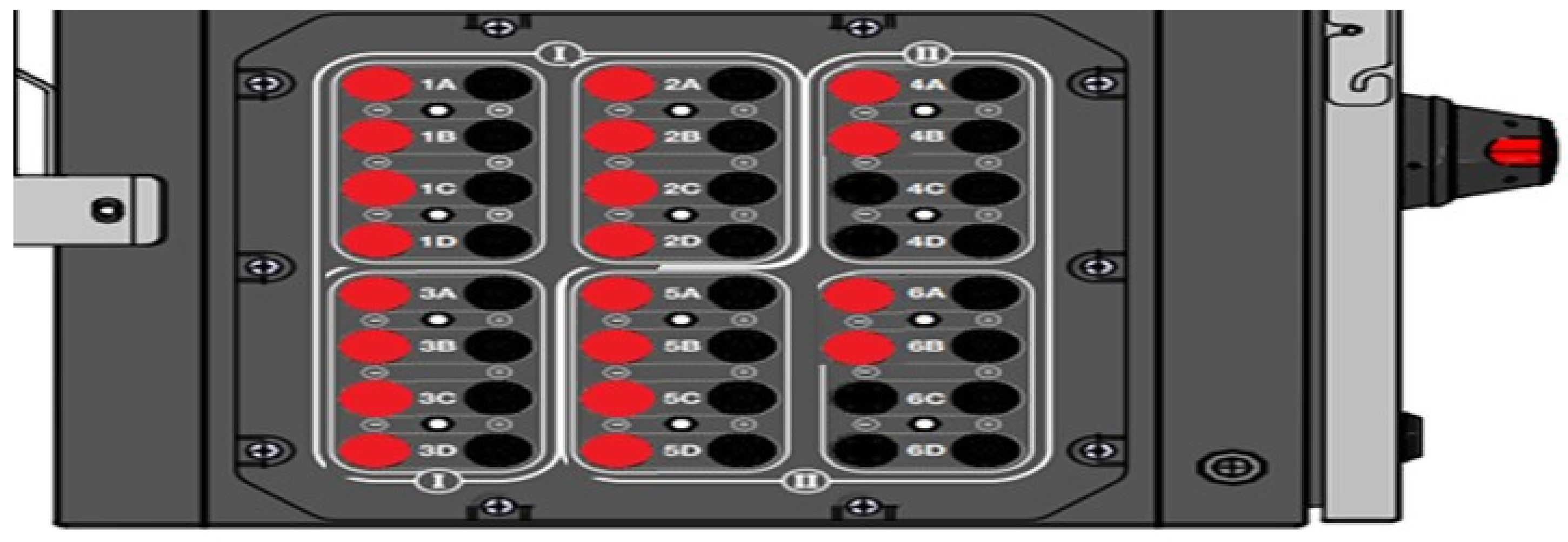
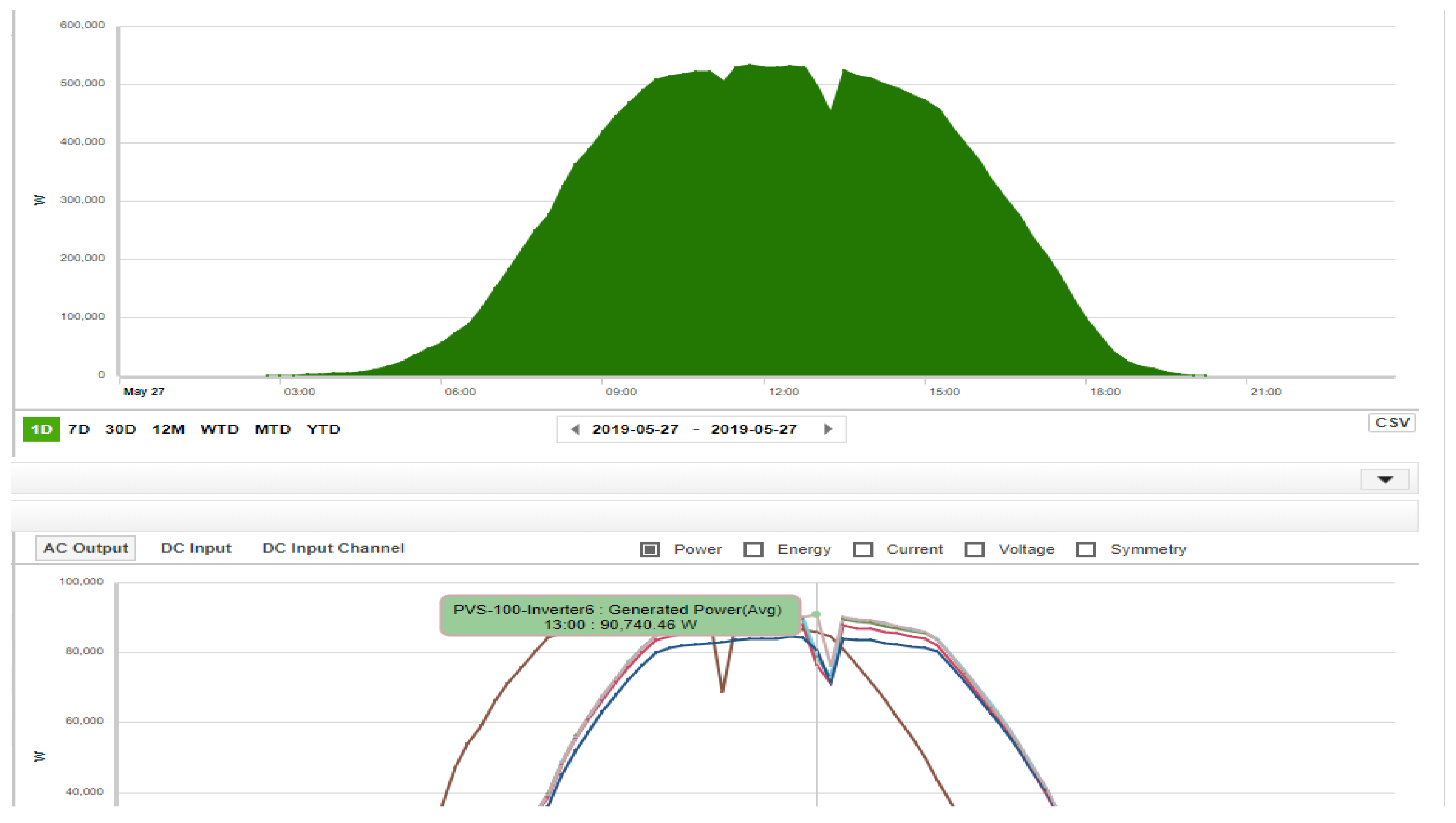
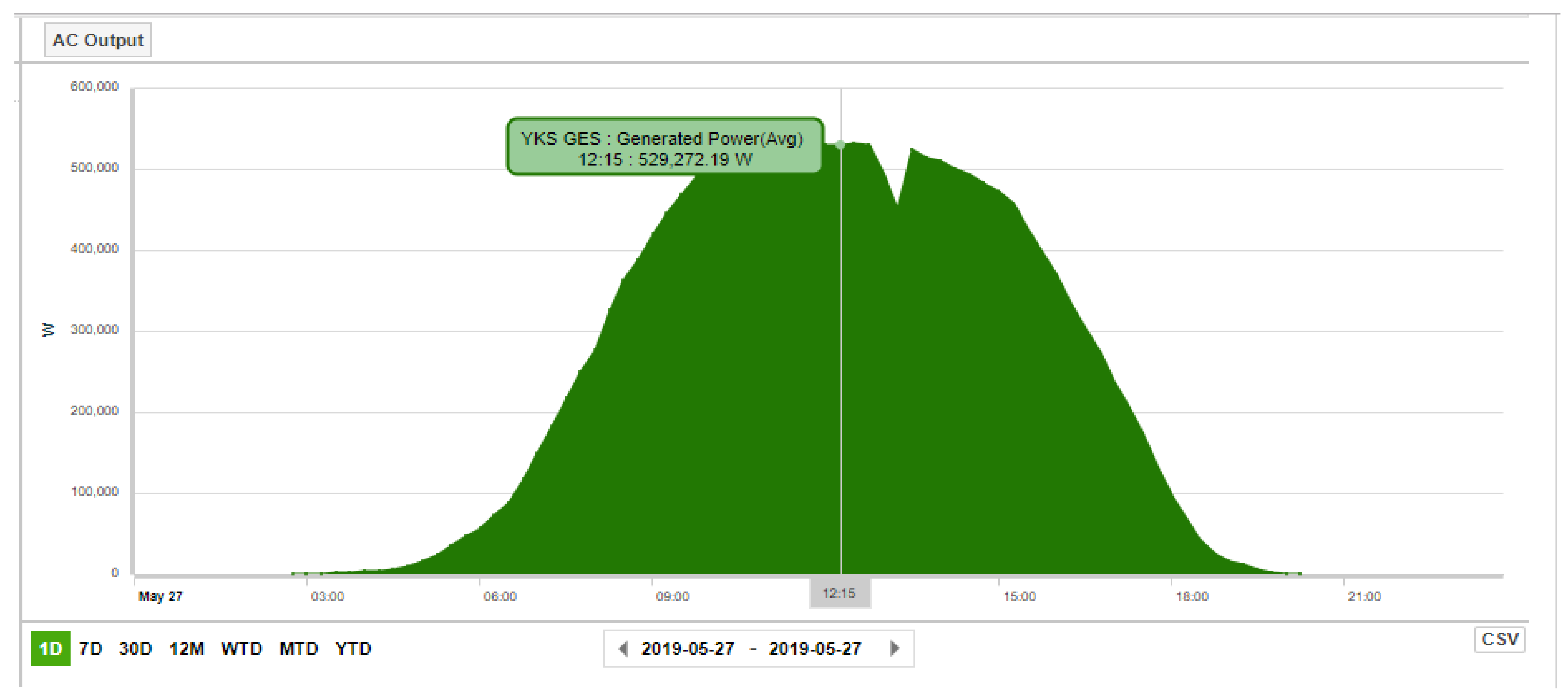

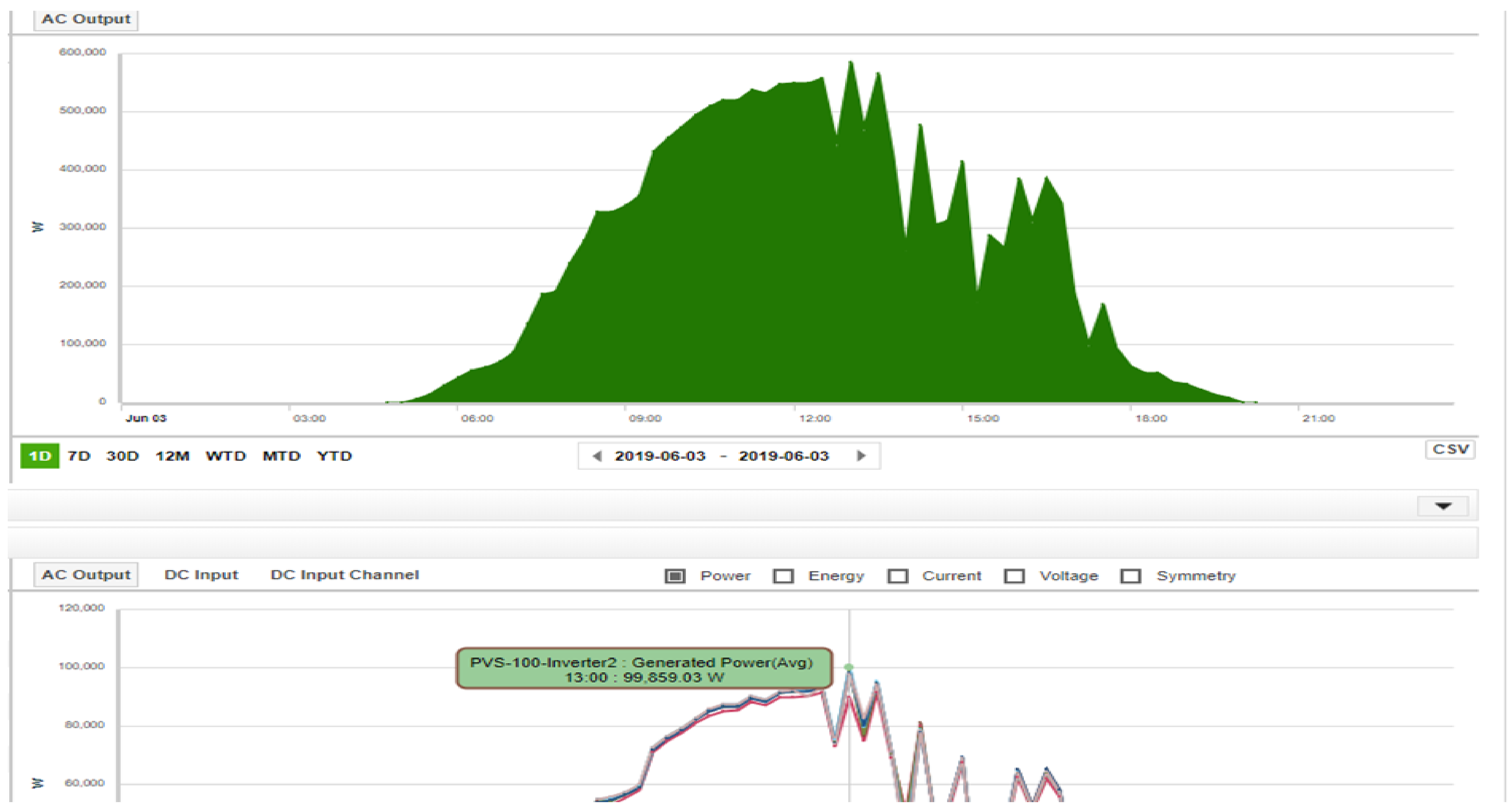
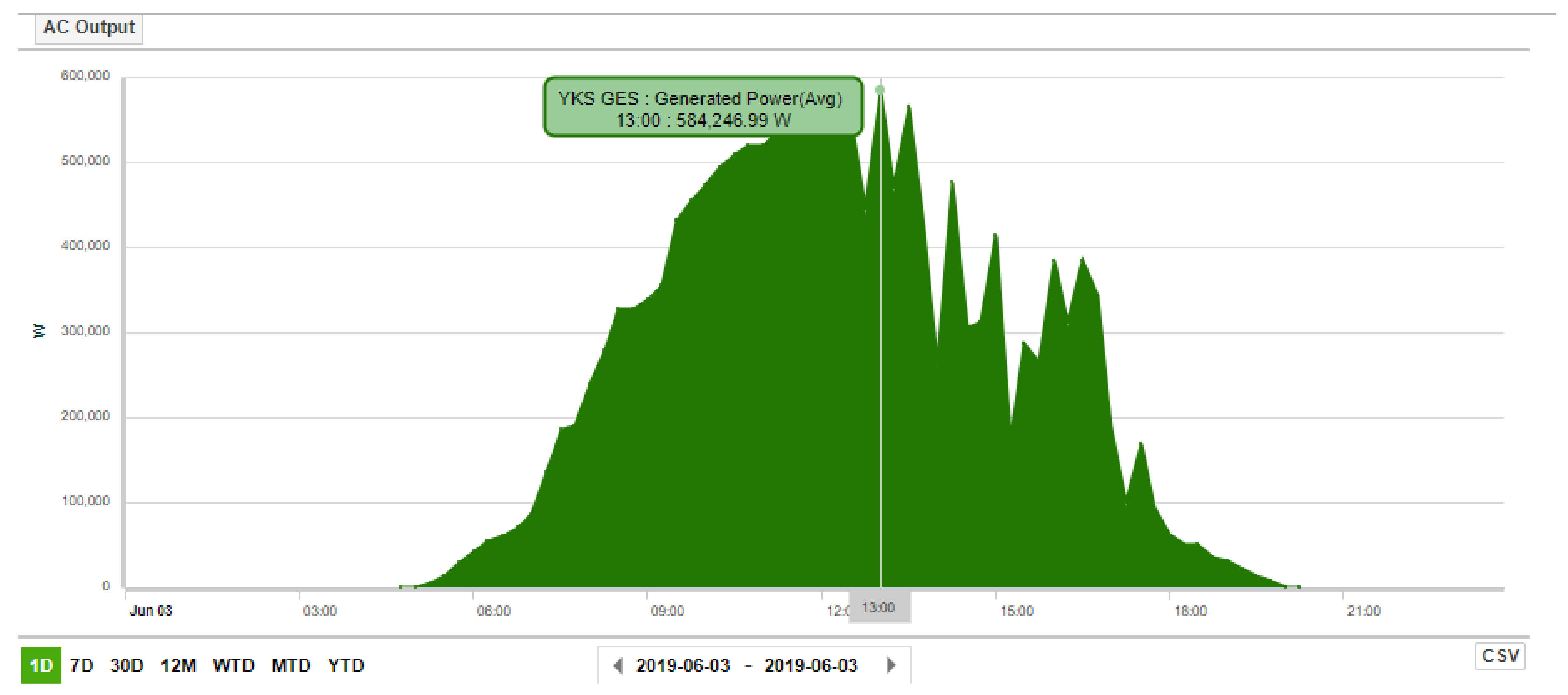
| Santral Name and Location | ESKO Energy Production Inc. Amasya Center Yagmur Village |
|---|---|
| DC-Installed Power | 1210 kW |
| AC-Generating Power | 990 kW |
| Inverter Brand Model | ABB-PVS100 |
| Number of Inverters | 10 |
| Number of DC Summation Boards | - |
| Panel Brand Model | HT Solar-Polycrystalline |
| Panel Power Number | 275 W-4400 |
| MV-LV Transformer Brand Model | ASTOR |
| MV-LV Transformer Power | 1250 kVA |
| MV Cell Brand Model | Ulusoy |
| LoM Relay Make Model | ABB CMUFD-Modbus |
| Transformer Protection Relay Brand Model | Thytronic NA21 |
| Rectifier Brand Model Other Information | Power Elektronic |
| Number and Power of Supplied Environmental Lighting | 3-SLDP Board |
| Security Building Feed Status | No |
| Compensation Power and Auto/Constant | Fixed 50 kVAR, disabled |
| Inverter Power Restriction Ratio | Inv-1 is restricted to 80%. |
| Regular Maintenance for PV Panel | Periods |
|---|---|
| Electrical and Mechanical controls for carrier system and panels Panel control (Thermal Drone) Connector, solar cable and connection equipment control | 6 months |
| Regular maintenance for Inverter | |
| Cleaning and isolation of the inverter due to humidity, heat and dust, checking the filters Physical condition and functionality check (for the Inverter and all auxiliary equipment) Checking and cleaning of sensors (for inverter) Inverter fault analysis by determining the source of faults | 6 months |
| Regular maintenance for Low voltage, Transformer and Medium voltage | |
| Control of LV panels (contactors, switches, fuses, terminals, sensors, etc. physical control, tightness checks and thermal measurements General control and maintenance of MV cells (physical control of breaker, measurement transformer, disconnector and fuses) System control (Compensation Board) Thermal measurement and tightness control (Lighting panel, DC/AC Panel Control) | 6 months |
| Regular maintenance for Communication | |
| Remote monitoring and controlling SCADA System | daily |
| Maintenance and control of communication infrastructure | monthly |
| Regular maintenance for General | |
| Control of MV and LV panels (control of door, lock mechanisms and barrier and movement mechanisms | 6 months |
| Control of indicator, warning and control buttons on MV and LV panels | 6 months |
| Visiting the site | monthly |
| Planned Maintenance and Service (submission of detailed activity reports within 5 working days at the latest) | weekly |
| Immediate response (team intervention within 24 hours by sending a team to the field to instantaneous malfunctions in the field) | when necessary |
| Control of consumption facilities within the framework of the service | monthly |
| SPP production performance report | monthly |
Disclaimer/Publisher’s Note: The statements, opinions and data contained in all publications are solely those of the individual author(s) and contributor(s) and not of MDPI and/or the editor(s). MDPI and/or the editor(s) disclaim responsibility for any injury to people or property resulting from any ideas, methods, instructions or products referred to in the content. |
© 2023 by the authors. Licensee MDPI, Basel, Switzerland. This article is an open access article distributed under the terms and conditions of the Creative Commons Attribution (CC BY) license (https://creativecommons.org/licenses/by/4.0/).
Share and Cite
Bakır, H.; Merabet, A. Evaluation and Solution Suggestions for Engineering and Workmanship Failures during Design and Installation of Solar Power Plants. Energies 2023, 16, 1457. https://doi.org/10.3390/en16031457
Bakır H, Merabet A. Evaluation and Solution Suggestions for Engineering and Workmanship Failures during Design and Installation of Solar Power Plants. Energies. 2023; 16(3):1457. https://doi.org/10.3390/en16031457
Chicago/Turabian StyleBakır, Hale, and Adel Merabet. 2023. "Evaluation and Solution Suggestions for Engineering and Workmanship Failures during Design and Installation of Solar Power Plants" Energies 16, no. 3: 1457. https://doi.org/10.3390/en16031457
APA StyleBakır, H., & Merabet, A. (2023). Evaluation and Solution Suggestions for Engineering and Workmanship Failures during Design and Installation of Solar Power Plants. Energies, 16(3), 1457. https://doi.org/10.3390/en16031457








